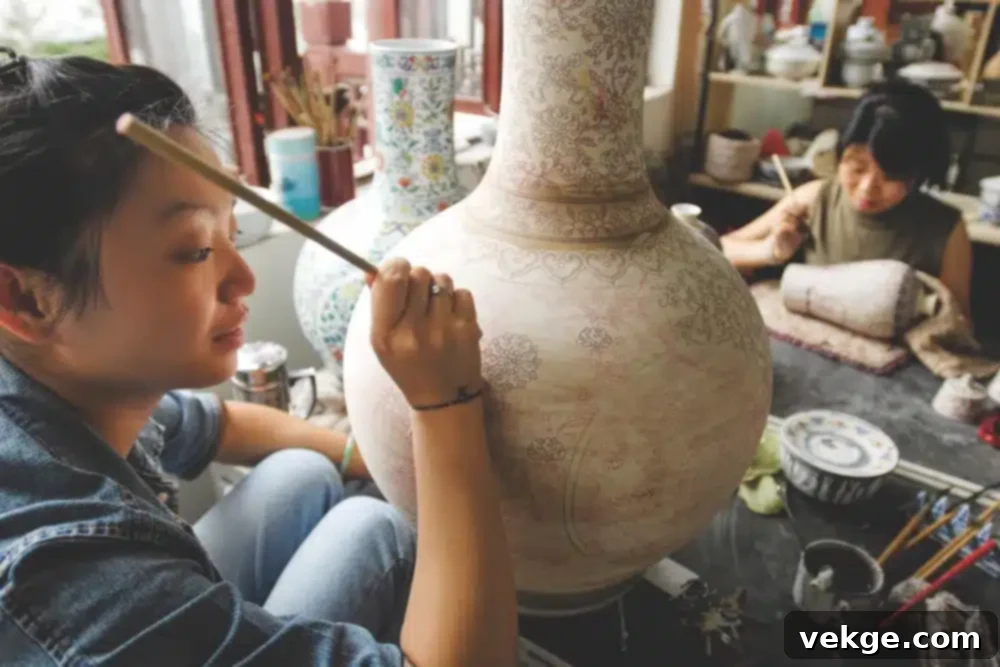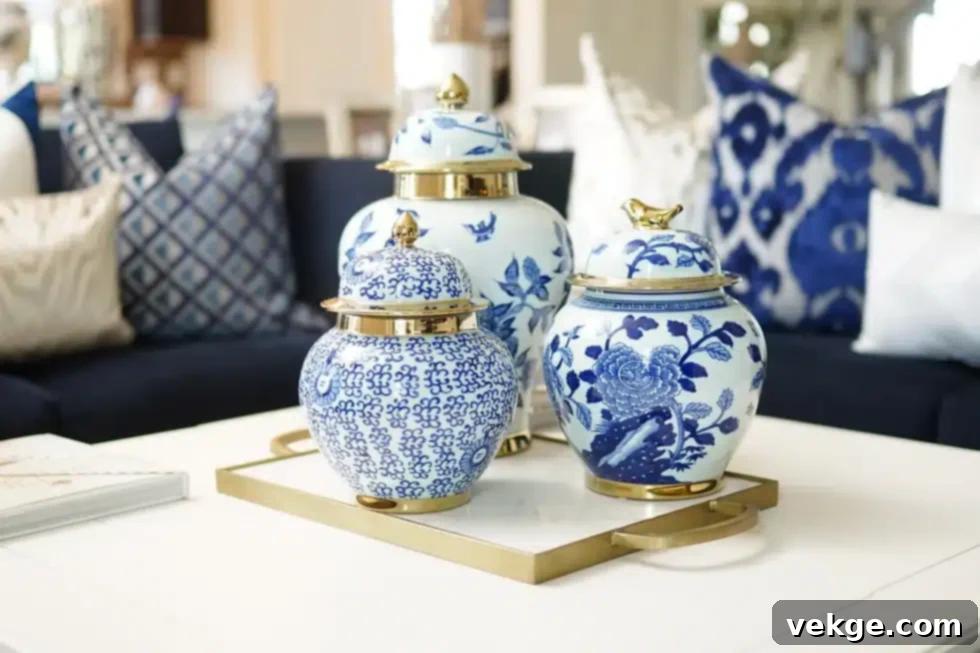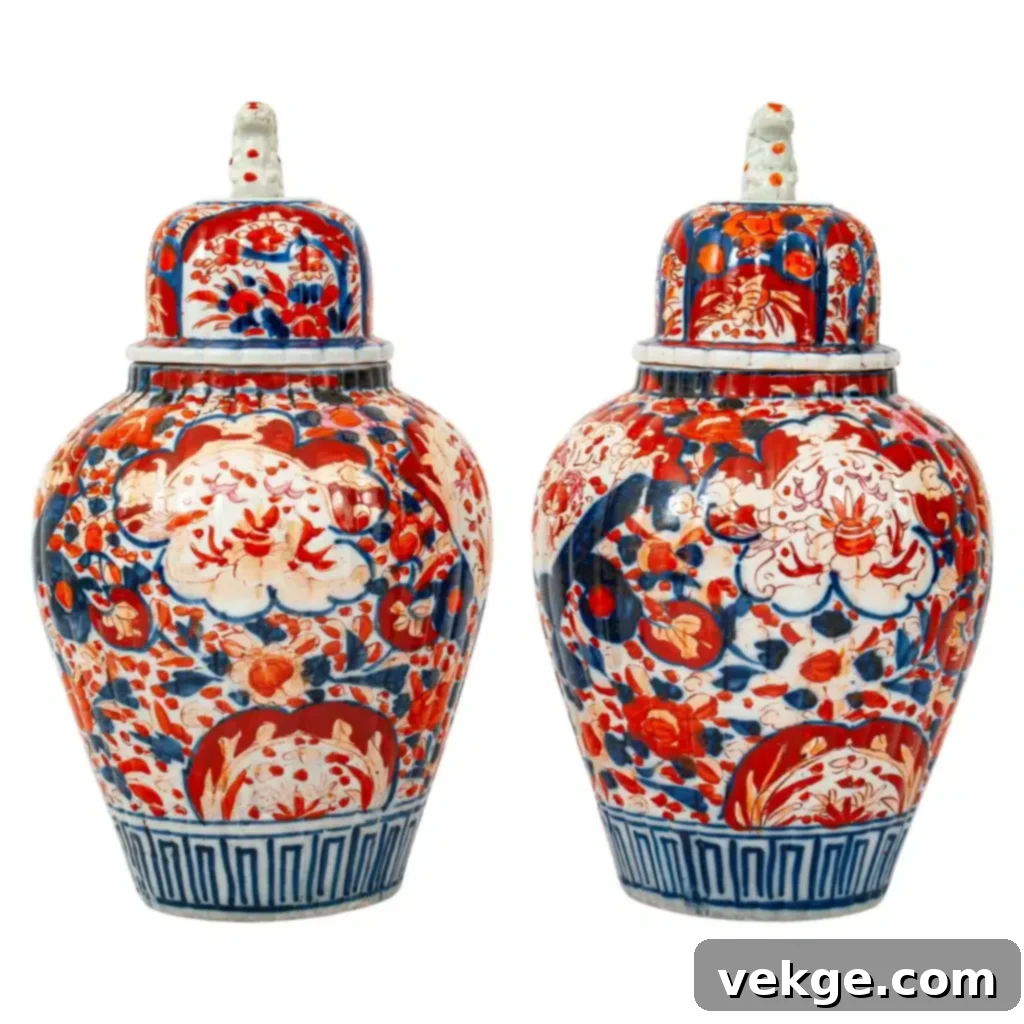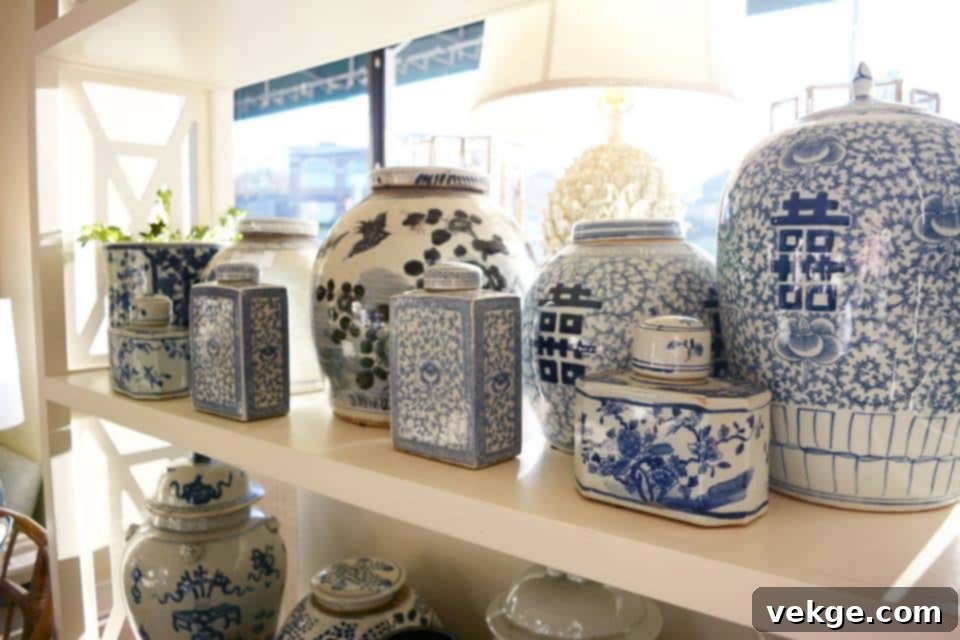The Enduring Charm of Ginger Jars: History, Styling, and Decor Ideas
For anyone passionate about home decor, the sight of a beautiful ginger jar is likely a familiar and cherished one. These distinctive decorative elements, with their high shoulders and characteristic domed caps, are more than just storage vessels; they are statements of timeless elegance and cultural heritage. Widely admired for their aesthetic appeal, ginger jars boast a rich history spanning over two millennia, evolving from practical containers to highly coveted ornamental pieces.
But what is it about these captivating jars that has sustained their popularity through centuries, allowing them to maintain a pivotal position in contemporary design trends? If you’re considering incorporating these exquisite pieces into your home or simply curious about their enduring allure, you’ve come to the right place. Join us as we delve into the fascinating world of ginger jars, uncovering their origins, exploring their rise to fame, and sharing inspiring ideas for styling them in your living spaces.
What Are Ginger Jars? An Introduction to Their Distinctive Beauty
At their core, ginger jars are traditional Chinese ceramic vessels, instantly recognizable by their elegant silhouette: a broad body that tapers towards a narrow neck, culminating in high, rounded shoulders and a stately domed lid. While often celebrated for their iconic blue and white patterns, depicting intricate scenes of nature, mythology, or traditional motifs, the world of ginger jars is far more diverse than many realize. As demand has evolved, so too has the variety of patterns, colors, and finishes available, making them versatile additions to almost any decor style.
Historically, these jars were crafted from glazed porcelain, a testament to the sophisticated ceramic artistry of ancient China. Over time, and with increased accessibility, many have come to be made from various types of ceramics. This shift has not only broadened their appeal but also made them more adaptable to modern manufacturing techniques and design sensibilities. Today, ginger jars are no longer confined to their conventional blue and white porcelain forms; you can find them in a myriad of styles, from sleek modern interpretations to rustic coastal or charming cottage designs, reflecting a fusion of traditional craftsmanship and contemporary aesthetics.
So, are ginger jars still in vogue? The answer is an unequivocal yes. Their popularity continues to soar, driven by a renewed appreciation for classic beauty, a desire for unique decorative accents, and the ever-growing trend of curating beautifully adorned homes. Their ability to effortlessly blend into various interior themes, from grandmillennial to minimalist, solidifies their status as a decor staple. But what exactly fuels this lasting appeal? Let’s explore the rich tapestry of their past.
A Deep Dive into the Rich History of Ginger Jars

The story of ginger jars begins over 2,000 years ago in ancient China, where they were initially crafted as utilitarian vessels. Their original purpose was far removed from mere decoration; they served as practical containers for storing and transporting precious spices, particularly ginger, to the Western world. This crucial role in the spice trade is precisely how they earned their evocative name. Imagine ancient trade routes, laden with exotic goods, where these very jars protected valuable commodities on long journeys across continents.
For centuries, these beautiful containers remained primarily functional. It wasn’t until the 19th century that Europe truly discovered and embraced their aesthetic charm. As the jars arrived in the West filled with spices, their exquisite craftsmanship and distinctive appearance caught the eye of collectors and decorators, transforming them from simple storage items into coveted ornamental pieces for homes and palaces alike.
The most iconic and widely recognized variation, the blue and white ginger jar adorned with intricate Chinese calligraphy, landscapes, and symbolic motifs, first emerged during the Yuan Dynasty, approximately 800 years ago. This particular style, celebrated for its delicate artistry and vibrant indigo hues, quickly became a hallmark of Chinese porcelain. As their decorative appeal grew in the West, the functional aspect of these jars gradually receded, cementing their status as purely decorative items. While the blue and white combination remains the most beloved, less common variations with brilliant colors and unique patterns also exist, though they are harder to find due to historical shifts in demand and production.
Unpacking the Enduring Popularity of Ginger Jars
The resurgence of ginger jar popularity, especially among younger demographics, is a fascinating phenomenon. In an age dominated by visual platforms like Instagram and Pinterest, these elegant pieces have found a new spotlight, captivating audiences with their photogenic qualities and timeless appeal. Several factors contribute to their sustained and even growing traction in the contemporary decor landscape:
From Porcelain to Accessible Ceramics
- Material Evolution: Traditionally, ginger jars were crafted from glazed porcelain, a premium material that contributed to their historical value and exclusivity. However, with evolving manufacturing techniques and design demands, there has been a significant shift towards more readily available ceramic materials. This transition has not only made them more adaptable to various styles but also more resilient for everyday use.
- Enhanced Affordability: The move to more accessible ceramic production has had a direct impact on cost. While antique porcelain ginger jars remain valuable collectibles, their modern ceramic counterparts are significantly more affordable. This price accessibility allows a broader audience to enjoy the beauty and sophistication of these decorative elements without a prohibitive investment, making luxurious aesthetics attainable for many.
Magnificent Variety and Versatility
- Diverse Designs and Colors: Beyond the classic blue and white, ginger jars are now available in an astonishing array of solid colors, unexpected hues, and intricate patterns. This expanded variety includes traditional motifs from different eras and regions, as well as modern, abstract designs. Such diversity ensures that there’s a ginger jar to complement every personal taste and interior design scheme, from vibrant contemporary spaces to serene minimalist settings.
- Broad Appeal: The extensive range of patterns, shapes, and designs means ginger jars can cater to a wide audience. Whether you’re seeking a touch of traditional grandeur, a pop of coastal charm, or a sleek modern accent, there’s a ginger jar perfectly suited to your needs. This versatility makes them incredibly convenient and desirable for decorators and homeowners alike.
The Social Media Effect
The visual nature of platforms like Instagram and Pinterest has played a crucial role in amplifying the popularity of ginger jars. Home decor influencers and designers frequently feature these jars in their curated spaces, showcasing their ability to add sophistication and visual interest. This constant exposure generates inspiration and desire, positioning ginger jars as must-have items for creating stylish and aspirational home environments.
Styling Your Home with Ginger Jars: Creative Decor Ideas
Incorporating ginger jars into your home decor is an excellent way to inject elegance and enhance your space’s overall appeal. One of their most delightful attributes is their adaptability; these decorative elements can be strategically placed in almost any room, offering endless possibilities for creative expression. Whether grouped for a grand statement or displayed solitarily as a striking focal point, ginger jars possess an inherent charm that elevates their surroundings. While personal taste dictates individual decor choices, here are a few universally appealing patterns and ideas to help you create a cohesive and captivating look.
1. The Classic Blue and White Statement

The blue and white ginger jar is arguably the most ubiquitous and enduring pattern, a design legacy tracing back to the 15th-century Ming dynasty. Its widespread appeal stems not only from its inherent beauty but also from its remarkable versatility. This timeless color combination effortlessly coordinates with nearly any existing color scheme, adding a touch of sophisticated contrast or harmonious blend.
For a traditional look, display a collection of varying sizes on a mantelpiece, sideboard, or bookshelf. You can choose to keep the lids on for a clean, sculptural effect, or remove them and fill the jars with fresh flowers, lush greenery, or even delicate branches. Consider selecting floral arrangements that contrast with your room’s dominant colors to create a vibrant focal point. For instance, white hydrangeas or vibrant pink peonies can truly pop against the classic blue and white, instantly elevating your home’s aesthetic game.
2. Embracing a Kaleidoscope of Patterns and Colors

Beyond the beloved blue and white, a world of other patterns and historical designs awaits, each with its own unique story and aesthetic. For instance, Imari jars, originating in 17th-century Japan, are celebrated for their rich, multi-colored palette, typically featuring vibrant reds, blues, and golds. These exquisite pieces often depict intricate scenes of dragons, flowers, or tranquil village landscapes, adding a dramatic flair to any space.
Other notable categories include ‘Famille Verte’ and ‘Famille Rose’ ginger jars, both originating from China. ‘Famille Verte’ pieces are characterized by their brilliant, clear enamel glazes, often featuring a dominant green hue alongside other vibrant colors. In contrast, ‘Famille Rose’ jars showcase opaque enamel, leading to softer, more delicate shades of pink, rose, and pastel tones. These diverse patterns allow for more eclectic decor choices, enabling you to layer different historical influences and color palettes within your home. Mix and match these patterns to create a truly unique and personalized collection that speaks volumes about your style.
3. Groupings and Arrangements
Whether you have a single standout piece or an entire collection, the way you arrange ginger jars can dramatically impact their visual effect. For a sophisticated look, group jars of varying heights and patterns in odd numbers (e.g., three or five) on a console table, a large coffee table, or built-in shelving. This creates dynamic visual interest and a sense of curated elegance. You can also mix them with other decorative elements like books, sculptures, or framed art to create a layered and textured display.
4. Seasonal and Themed Decor
Ginger jars are incredibly adaptable for seasonal decorating. During the holidays, fill them with festive ornaments, pinecones, or twinkling fairy lights. In spring, they can beautifully house delicate cherry blossoms or tulips. For a coastal theme, consider filling a jar with seashells or sand, transforming it into a personalized beach-inspired accent. Their versatility makes them perfect year-round companions for your evolving decor needs.
5. Beyond the Traditional: Modern Interpretations
Don’t limit ginger jars to traditional settings. They can seamlessly integrate into modern and minimalist interiors. Opt for solid-colored ginger jars in neutral tones like white, black, or grey for a sleek, contemporary look. Place a single large jar in a minimalist living room as a sculptural art piece, or use a pair to frame a piece of modern art. Their classic shape, when rendered in a contemporary finish, creates an intriguing juxtaposition that adds depth and character to modern spaces.
Choosing the Perfect Ginger Jar for Your Space
When selecting ginger jars, consider the scale of your room and the specific area where they will be placed. A large, ornate jar might overwhelm a small side table but could be a magnificent centerpiece on a grand dining table or a focal point in an entryway. Conversely, smaller jars can be tucked into bookshelves, added to bathroom vanities, or used as accents on nightstands.
Think about the existing color palette and style of your home. While blue and white jars are famously versatile, a bold, multi-colored Imari jar might be the perfect complement to a room with rich jewel tones, or a simple white ceramic jar could enhance a calm, Scandinavian-inspired space. Don’t be afraid to mix and match different styles or periods if it resonates with your personal aesthetic – often, the most interesting interiors are those that tell a story through a curated collection of diverse pieces.
Finally, inspect the quality. Look for jars with well-executed patterns, smooth glazes, and sturdy construction. If purchasing antique pieces, research their provenance and condition. Whether new or old, a well-chosen ginger jar is an investment in timeless beauty that will bring joy for years to come.
Conclusion: A Timeless Touch for Every Home
Ginger jars stand as a remarkable testament to the enduring power of decorative and historical elements, seamlessly integrated into contemporary home decor. Their incredible journey from humble spice containers to highly sought-after design components underscores their timeless appeal and remarkable adaptability. From their ancient Chinese origins to their captivating presence on social media platforms, these beautiful jars have consistently evolved, captivating new generations with their elegance.
The rise in popularity among younger generations and their prominent feature on visual platforms like Instagram and Pinterest further exemplifies their versatility across myriad decor styles—from classic and traditional to coastal, modern, and even eclectic grandmillennial aesthetics. Adding ginger jars to your interior decor is more than just a style decision; it’s an homage to magnificent craftsmanship, a celebration of rich cultural heritage, and a nod to a design element that has only improved with age.
We hope this article has shed light on the enchanting world of ginger jars and inspired you to discover how these magical decor pieces can transform your living spaces. What are your thoughts? How do you envision styling ginger jars in your home? Share your experiences and opinions about these captivating decorative treasures in the comments below!
